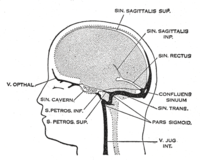
Photo from wikipedia
Objectives The aim is to evaluate venous stent patency, the development of post-thrombotic syndrome, recurrence, quality of life and the optimal post-procedural anticoagulation regimen in the treatment of iliofemoral deep… Click to show full abstract
Objectives The aim is to evaluate venous stent patency, the development of post-thrombotic syndrome, recurrence, quality of life and the optimal post-procedural anticoagulation regimen in the treatment of iliofemoral deep venous thrombosis. Method and results EMBASE and Medline databases were interrogated to identify studies in which acute deep venous thrombosis patients were stented. Twenty-seven studies and 542 patients were identified. Primary, assisted primary and secondary patency rates 12 months after stent placement ranged from 74 to 95, 90 to 95 and 84 to 100%, respectively. The observed post-thrombotic syndrome rate was 14.6%. The incidence of stent re-thrombosis was 8%. In 26% of studies, patients received additional antiplatelet therapy. Quality of life questionnaires employed in 11% of studies, demonstrating an improvement in the chronic venous insufficiency questionnaire (22.67 ± 3.01 versus 39.34 ± 6.66). Conclusion Venous stenting appears to be an effective adjunct to early thrombus removal; however, further studies are needed to identify optimal anticoagulant regimen and effect on quality of life.
Journal Title: Phlebology
Year Published: 2019
Link to full text (if available)
Share on Social Media: Sign Up to like & get
recommendations!